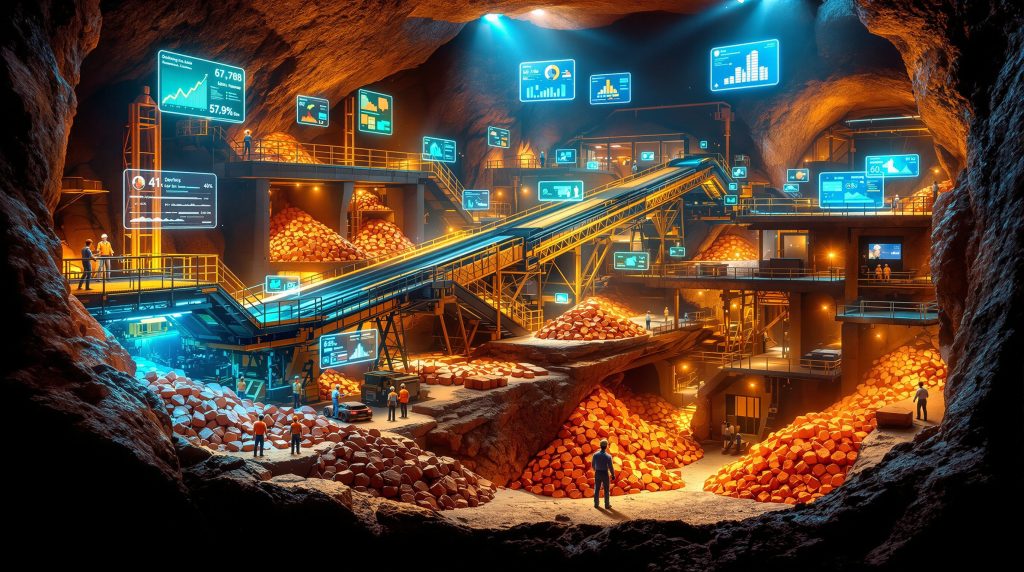What Makes Mining Operations So Complex in Today's Industry?
Mining operations face unprecedented complexity levels as companies navigate deeper extraction sites, declining mineral concentrations, and increasingly sophisticated technological requirements. Modern mining enterprises must balance production efficiency with environmental stewardship while managing intricate supply chains and regulatory frameworks that span multiple jurisdictions.
The operational complexity in mining industry has emerged as the primary concern for executives worldwide, representing a fundamental shift from external market pressures to internal operational control challenges. This transformation reflects the industry's evolution as companies have progressively addressed geopolitical and regulatory risks, now focusing on optimising their core operational capabilities through data-driven operations.
The Evolution of Mining Complexity Challenges
Mining complexity has fundamentally transformed over the past decade, shifting from external market pressures to internal operational hurdles. According to a comprehensive global survey of approximately 500 mining executives conducted across multiple organisational levels, operational complexity now ranks as the top risk factor in the industry's risk assessment framework.
Companies now confront multifaceted challenges that require integrated solutions across geology, engineering, technology, and human resources management. The progression represents a strategic pivot where organisations have systematically addressed external risks and now concentrate on ensuring operations remain simplified and productive despite increasingly challenging extraction conditions.
The convergence of declining ore grades, capital scarcity, and labour shortages creates a perfect storm requiring operational simplification strategies. Industry leaders recognise that maximising asset utilisation has become essential as companies must extract maximum value from existing infrastructure while managing increasingly complex geological and operational parameters.
How Are Declining Ore Grades Reshaping Mining Economics?
The Mathematics of Diminishing Returns
Lower-grade deposits demand exponentially more processing to achieve equivalent metal output, fundamentally altering the economic equation for mining operations. When grades decline whilst mineral demand increases, operations must process significantly larger volumes of material through their processing systems, creating mathematical constraints on profitability that force comprehensive operational reassessment.
This reality forces companies to optimise every aspect of their extraction and processing workflows, from blast design to metallurgical recovery systems. The compounding effect of declining grades means that traditional operational approaches become economically unsustainable, requiring innovative solutions to maintain competitiveness.
Economic Pressure Points
Operations must maintain profitability whilst processing increasingly dilute ore bodies, creating pressure to implement advanced technologies and optimise processes continuously. The economic challenge extends beyond simple volume increases, encompassing energy consumption escalation, equipment utilisation intensification, and waste management complexity.
Capital constraints further complicate the situation, as companies must achieve maximum asset utilisation without substantial new investments. This economic reality drives the necessity for operational simplification and technological integration to maintain viable production levels while managing expanding cost structures.
Furthermore, companies are increasingly turning to modern mine planning techniques to address these economic pressures through enhanced forecasting and resource allocation strategies.
Why Are Deeper Mining Operations Creating New Challenges?
Infrastructure and Energy Demands
Deeper extraction sites require sophisticated ventilation systems, advanced pumping infrastructure, and enhanced safety protocols that multiply operational complexity exponentially. The infrastructure demands of deep mining operations extend far beyond traditional surface mining requirements, necessitating specialised equipment and support systems that operate under extreme conditions.
Energy consumption patterns shift dramatically with increased depth, particularly affecting underground operations where power requirements for ventilation, dewatering, and material transport create substantial operational overhead. These infrastructure demands require careful integration with production planning to ensure economic viability.
Logistical Complexity Factors
- Transportation Networks: Longer haul distances from extraction points to processing facilities create scheduling and equipment utilisation challenges
- Material Handling: Multi-stage conveyor systems and elevated maintenance requirements increase operational coordination complexity
- Safety Systems: Enhanced emergency response protocols and monitoring technologies require specialised workforce training and system integration
- Workforce Management: Specialised training for extreme depth operations creates human resource development challenges and knowledge transfer requirements
What Role Does Technology Play in Managing Operational Complexity?
Artificial Intelligence Applications
Diagnostic Capabilities
AI systems excel at processing vast volumes of unstructured data from multiple operational sources to identify failure points and deviations from planned operations. The diagnostic function enables operations to understand where systems fail and where performance deviates from expectations, providing crucial insights for operational optimisation.
Machine learning algorithms analyse complex datasets spanning geological information, equipment performance metrics, and production variables to provide actionable insights that human operators cannot efficiently process independently. This technological advancement is part of the broader trend of ai in mining processes revolutionising traditional operational approaches.
Process Optimisation
Advanced AI systems create predictable and disciplined operational frameworks that can be systematically supported by automated decision-making processes. This streamlining function enables operations to maintain consistency whilst reducing the complexity burden on human operators.
The technology facilitates real-time parameter adjustments based on changing ore characteristics, equipment performance indicators, and production targets, creating dynamic optimisation capabilities that adapt to operational variations.
Predictive Analytics
AI platforms identify previously unrecognisable opportunities by processing enormous datasets that exceed human analytical capacity. These predictive capabilities reveal unforeseen operational opportunities and potential optimisation pathways that emerge from comprehensive data analysis.
The technology enables advanced market responsiveness, allowing operations to adjust production parameters based on commodity market changes and optimise operational levers according to external economic conditions. According to EY's global mining survey, operational complexity has become the most significant risk factor facing mining companies worldwide.
Digital Transformation Benefits
Digital transformation initiatives enable mining operations to implement statistical process control systems that minimise operational deviations and improve consistency. These systems create tighter operational control through continuous monitoring and automated adjustment capabilities.
Technology integration extends to surveying operations through drone deployment, replacing traditional survey systems with more efficient and accurate data collection methods. Communication infrastructure improvements, including mesh networking systems, facilitate rapid information flow to decision-makers across large mining sites.
How Do Mining Companies Address Workforce Complexity?
Experience Gap Management
The mining industry faces significant knowledge transfer challenges as experienced personnel retire, creating experience gaps at all operational levels. This workforce transition coincides with labour scarcity issues that compound operational complexity management challenges.
Companies are developing comprehensive strategies to bridge knowledge gaps whilst maintaining operational standards. The approach involves using technology platforms to augment less experienced workers' decision-making capabilities by providing structured options rather than leaving personnel to navigate complex information independently.
However, addressing these workforce development challenges requires innovative approaches to talent acquisition, retention, and skills development across diverse demographic groups.
AI-Assisted Decision Making
Technology platforms provide structured decision-making support for personnel with limited operational experience, reducing the learning curve whilst maintaining operational standards. These systems offer multiple solution options for operational challenges, enabling workers to make informed decisions without extensive experience bases.
The AI augmentation approach recognises that workforce development requires systematic support rather than trial-and-error learning in complex operational environments. This methodology preserves operational quality whilst accommodating workforce transitions.
Training and Development Strategies
- Simulation-Based Learning: Virtual reality training for high-risk scenarios creates safe learning environments for complex operational procedures
- Cross-Functional Skill Development: Multi-discipline training programmes develop versatile operational capabilities across functional boundaries
- Continuous Education: Ongoing technical certification requirements ensure workforce competency maintenance in evolving technological environments
- Knowledge Management Systems: Digital platforms facilitate sharing of best practices and institutional knowledge preservation
What Are the Key Strategies for Simplifying Mining Operations?
Integrated Planning Systems
Successful operations eliminate silos between geological planning, production scheduling, and execution teams, creating seamless coordination from geological assessment through final product delivery. Integrated planning systems represent one of the fundamental requirements for managing operational complexity effectively.
The integration extends beyond traditional planning boundaries to encompass supporting functions including maintenance scheduling and workforce management. This comprehensive approach ensures that all operational elements align with overall production objectives whilst maintaining operational flexibility.
Flexibility and Responsiveness
Adaptive Production Management
Mining operations must excel at managing deviations from planned activities, as geological variations and equipment performance issues inevitably create operational disruptions. The operational challenge involves responding effectively to unplanned situations without compromising long-term planning objectives or cannibalising future production capacity.
Successful operations develop systematic approaches to deviation management that preserve overall plan integrity whilst accommodating necessary operational adjustments. This capability requires sophisticated coordination between planning and execution functions.
Debottlenecking Initiatives
Large-scale operations require systematic identification and elimination of production constraints through comprehensive value chain analysis. Debottlenecking efforts focus on simplifying operational complexity rather than adding technological sophistication that creates additional management overhead.
The approach emphasises streamlining existing processes and eliminating unnecessary complexity that impedes operational efficiency. This philosophy prioritises operational simplicity over technological complexity when both approaches can achieve similar results.
Technology Integration Examples
- Drone-Based Surveying: Advanced aerial surveying systems replace traditional ground-based survey methods, improving accuracy and reducing operational disruption
- Mesh Networking: Comprehensive communication infrastructure enables rapid information flow across extensive mining sites to support real-time decision-making
- Statistical Process Control: Continuous monitoring systems track key performance indicators and implement automatic corrections to minimise operational deviations
How Do Environmental and Community Factors Add to Operational Complexity?
Regulatory Compliance Management
Modern mining operations navigate increasingly complex regulatory frameworks covering environmental protection, worker safety, and community engagement across multiple jurisdictions. Compliance requirements vary significantly between regions, creating operational complexity for companies operating in diverse geographical areas.
Operations in frontier jurisdictions present particular challenges where regulatory frameworks may be evolving or inconsistent. Companies must develop adaptive compliance strategies that accommodate regulatory variations whilst maintaining operational efficiency across their portfolio of operations.
Community Partnership Development
Beyond Traditional Agreements
Leading mining companies recognise that sustainable community relationships require comprehensive partnerships that extend beyond traditional royalty payments and employment opportunities. The industry has evolved toward genuine economic empowerment and development partnerships rather than transactional relationships with local communities.
Major mining organisations participate in industry-wide initiatives that disclose partnership agreements and investment commitments beyond traditional government tax payments. These partnerships focus on long-term economic development and capacity building rather than short-term transactional benefits.
Ecosystem Integration
Mining operations increasingly consider broader environmental and social impacts through comprehensive ecosystem approaches:
- Flora and fauna interaction studies that inform operational planning and environmental mitigation strategies
- Water resource management programmes that address long-term watershed sustainability and community water security
- Cultural heritage preservation initiatives that protect and celebrate indigenous cultural assets in operational areas
- Local economic development programmes that create sustainable economic opportunities beyond direct mining employment
Trust-Building Strategies
The mining sector has shifted toward proactive community engagement that goes beyond government compliance requirements. Companies recognise that regulatory requirements may change with political transitions, making genuine community partnerships more valuable than simple regulatory compliance.
This evolution reflects industry recognition that sustainable community relationships require genuine partnership approaches rather than compliance-driven interactions. Companies develop long-term community investment strategies that create mutual value and operational sustainability.
What Does the Future Hold for Mining Operational Complexity?
Emerging Technology Applications
Advanced Analytics
Next-generation systems will integrate geological, operational, and market data to optimise decision-making across comprehensive mining value chains. These platforms will extend beyond traditional operational boundaries to include market responsiveness and community interaction optimisation.
Future analytical systems will enable mining operations to adjust production parameters based on real-time market conditions whilst maintaining community relations and environmental compliance objectives simultaneously. These developments are part of the broader industry evolution trends reshaping the mining sector.
Autonomous Operations
Increased automation will reduce human exposure to hazardous conditions whilst improving consistency and efficiency in routine operational tasks. Autonomous systems will particularly benefit deep mining operations where human safety risks are highest and operational consistency requirements are most stringent.
The progression toward automation requires operational simplification as foundation technology, since automated systems function most effectively in predictable and well-controlled operational environments.
Sustainable Processing
Emerging technologies focus on reducing energy consumption, water usage, and waste generation whilst maintaining or improving recovery rates from increasingly challenging ore bodies. These innovations address the fundamental challenge of processing larger volumes of lower-grade materials economically.
Sustainable processing technology development aligns with community partnership objectives by reducing environmental impacts whilst maintaining operational economic viability. Research from McKinsey's operational excellence insights highlights the critical importance of operational simplification in achieving sustainable performance improvements.
Strategic Adaptation Requirements
Companies that successfully navigate operational complexity will demonstrate comprehensive management capabilities across multiple operational dimensions:
- Systematic Approach: Comprehensive management systems that coordinate geological planning through final product delivery whilst maintaining operational flexibility
- Continuous Improvement: Regular assessment and optimisation of operational processes with emphasis on simplification rather than technological complexity
- Technology Integration: Strategic adoption of digital solutions that augment human capabilities rather than creating additional operational complexity
- Stakeholder Engagement: Proactive community and regulatory relationship management that creates sustainable operational foundations
The mining industry's operational complexity in mining industry represents both significant challenges and substantial opportunities for companies willing to invest in comprehensive solutions. Success requires integrated approaches that combine technological innovation, workforce development, and stakeholder engagement to create sustainable competitive advantages.
Future industry leaders will distinguish themselves through their ability to simplify complex operations whilst maintaining high performance standards across production, environmental, and community relationship objectives. The operational complexity in mining industry challenge will likely intensify as ore grades continue declining and extraction sites become more challenging, making operational excellence an increasingly critical competitive differentiator.
Disclaimer: This analysis includes forward-looking perspectives on mining industry trends and technology adoption. Actual operational outcomes may vary based on commodity markets, regulatory changes, and technological development timelines. Readers should conduct independent research before making operational or investment decisions based on industry trend analysis.
Looking to Capitalise on Mining Operational Excellence?
Whilst mining companies grapple with increasing operational complexity, Discovery Alert's proprietary Discovery IQ model identifies ASX mineral discoveries that could benefit from these operational advances, delivering real-time alerts on significant discoveries before the broader market responds. Begin your 30-day free trial today to position yourself ahead of operational excellence opportunities in the mining sector.




